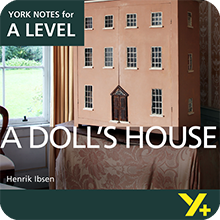Examiner's Notes
You assessed this answer as a Mid.
Hover over the highlighted text to read the examiner’s comments. These are linked to the Assessment Objectives, which are listed in the side panel.
In this play Ibsen is mainly doing comic relief. It is a depressing play with a sad ending and the audience needs to be cheered up. where Helmer tries to tell Mrs Linde that she should do embroidery and not knitting. For instance when Mrs Linde tells Nora that they are going to let Helmer read the letter we know Nora is thinking of suicide, but instead of letting her say so straight away there is a funny scene
Chaucer’s tale is different, his story is funny although it takes him a lot of time to get to the comic part and there is a lot of debate about marriage. It is as if he is being serious first so that we think about whether the funny scene at the end is really funny at all.
Nora is often funny in the play. She is very silly, when she says that society is boring. And it is comic when she eats the macaroons, because she has to hide them from Helmer and she has to gobble them up and this will make a mess. It is not so funny when Helmer makes her practically swear on the Bible that she hasn’t been eating sweets. Ibsen is making a contrast here.
Helmer also has comic moments. He stamps about shouting a lot. When he dismisses Krogstad he looks absurd, although it is not funny that a man loses his job. But Helmer says it is for calling him by his Christian name, and this makes him look silly. He also calls Nora ‘Little Miss Obstinate’ and this is funny, especially because I think she is right, it is a really stupid reason and not at all fair. Nora might give Helmer a look here and she uses words like ‘petty’. She has never criticised him before. Helmer might have a shocked look on his face, which would be funny. Ibsen is showing it is comic that a woman could think all this about fairness and pettiness, and not a man, even though Helmer has had all the education. Chaucer is also showing that a woman is cleverer than a man. But Nora is more real as a person and Ibsen might be showing that the change in her is the sort of change a woman of his time might really make, while there does not seem to be any feminist side to what the Merchant’s tale is saying.
Nora and Rank make a lot of jokes together, they are a bit like comedians doing a double act. These days people do not find them so funny as it is all right to talk about things like sexually transmitted diseases, so it is not funny to us that they are discussing asparagus and oysters instead. But I think Ibsen wanted to show that they are really close, so that at the end they say goodbye without really saying it, and they could not do that so well if they did not have some private language already to make jokes in and talk about serious issues.
The idea of private language is not something Chaucer could really do as people did not expect naturalism, but he does tell us a lot about the Merchant by showing him getting ready for his tale. The Merchant says marriage is a ‘snare’. He is probably telling the tale because he is unhappy. This comes across even though it is a comic story. But he also makes Januarie such a fool that it is hard to feel sorry for him, with all his friends giving him advice. And there are no pictures of happy marriage around to make a contrast – Proserpina and Pluto are not very happy either.
Ibsen shows us a happy time, Christmas, when there is a lot of potential for comedy, like the hiding of the tree and Nora asking for money. He shows that it can go wrong if people don’t pay proper attention to their marriage and that women have rights. The comedy helps this because it makes us think. Both stories make the audience think and they do it through contrasting tragic and comic parts.
